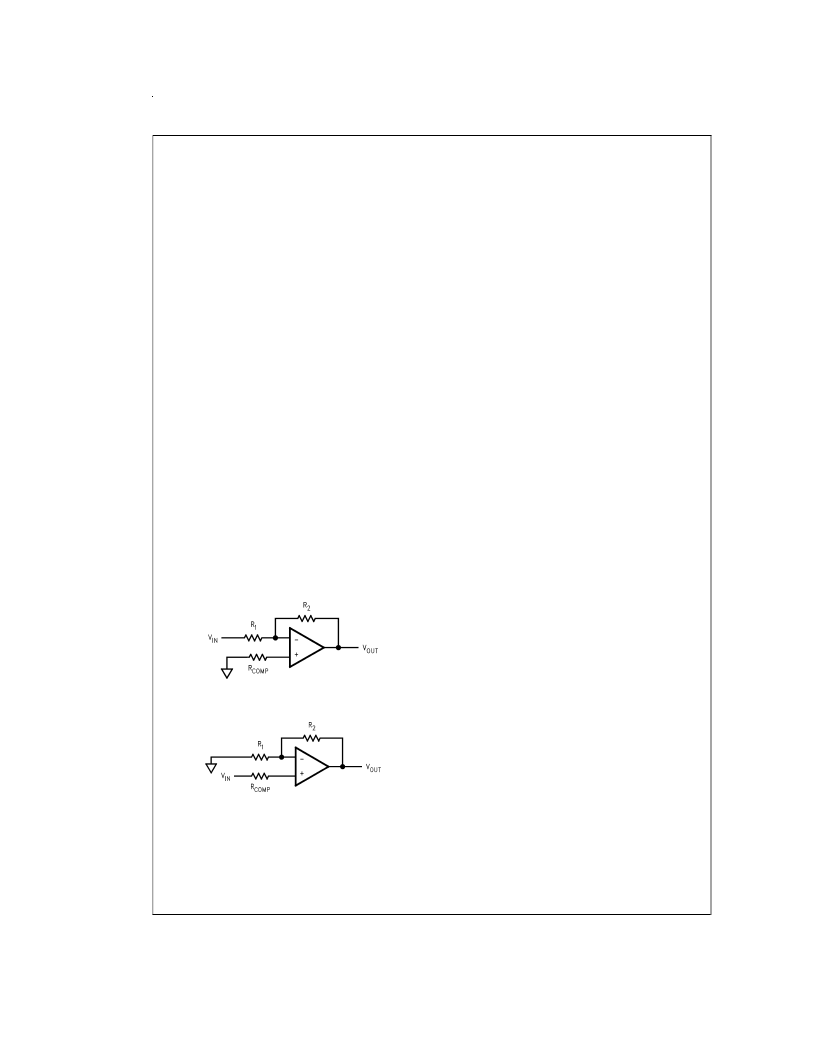- 您現在的位置:買賣IC網 > PDF目錄361043 > LMV751M5X (NATIONAL SEMICONDUCTOR CORP) Low Noise, Low Vos, Single Op Amp PDF資料下載
參數資料
| 型號: | LMV751M5X |
| 廠商: | NATIONAL SEMICONDUCTOR CORP |
| 元件分類: | 運算放大器 |
| 英文描述: | Low Noise, Low Vos, Single Op Amp |
| 中文描述: | OP-AMP, 1500 uV OFFSET-MAX, 4.5 MHz BAND WIDTH, PDSO5 |
| 封裝: | SOT-23, 5 PIN |
| 文件頁數: | 6/8頁 |
| 文件大小: | 259K |
| 代理商: | LMV751M5X |

Application Hints
1.0 Noise
There are many sources of noise in a system: thermal noise,
shot noise, 1/f, popcorn noise, resistor noise, just to name a
few. In addition to starting with a low noise op amp, such as
the LMV751, careful attention to detail will result in the low-
est overall noise for the system.
1.1 To invert or not invert
Both inverting and non-inverting amplifiers employ feedback
to stabilize the closed loop gain of the block being designed.
The loop gain (in decibels) equals the algebraic difference
between the open loop and closed loop gains. Feedback im-
proves the Total Harmonic Distortion (THD) and the output
impedance. The various noise sources, when input referred,
are amplified, not by the closed loop gain, but by the noise
gain. For a non-inverting amplifier, the noise gain is equal to
the closed loop gain, but for an inverting amplifier, the noise
gain is equal to the closed loop gain plus one. For large
gains, e.g., 100, the difference is negligible, but for small
gains, such as one, the noise gain for the inverting amplifier
would be two. This implies that non-inverting blocks are pre-
ferred at low gains.
1.2 Source impedance
Because noise sources are uncorrelated, the system noise
is calculated by taking the RMS sum of the various noise
sources, that is, the square root of the sum of the squares.At
very low source impedances, the voltage noise will domi-
nate; at very high source impedances, the input noise cur-
rent times the equivalent external resistance will dominate.
For a detailed example calculation, refer to Note 1.
1.3 Bias current compensation resistor
In CMOS input op amps, the input bias currents are very low,
so there is no need to use R
(Figure 1 and 2) for bias
current compensation that would normally be used with early
generation bipolar op amps. In fact, inclusion of the resistor
would act as another thermal noise source in the system, in-
creasing the overall noise.
1.4 Resistor types
Thermal noise is generated by any passive resistive ele-
ment. This noise is
″
white
″
; meaning it has a constant spec-
tral density. Thermal noise can be represented by a mean-
square voltage generator e
R2
in series with a noiseless
resistor, where e
R2
is given by: Where:
e
R2
= 4K TRB (volts)
2
Where T = temperature in K
R = resistor value in ohms
B = noise bandwidth in Hz
K = Boltzmann’s constant (1.38 x 10-23 W-sec/K)
Actual resistor noise measurements may have more noise
than the calculated value. This additional noise component is
known as excess noise. Excess noise has a 1/f spectral re-
sponse, and is proportional to the voltage drop across the re-
sistor. It is convenient to define a noise index when referring
to excess noise in resistors. The noise index is the RMS
value in uV of noise in the resistor per volt of DC drop across
the resistor in a decade of frequency. Noise index expressed
in dB is:
NI = 20 log ((E
EX
/V
DC
) x 10
6
) db
Where: E
EX
= resistor excess noise in uV per frequency de-
cade.
V
DC
= DC voltage drop across the resistor.
Excess noise in carbon composition resistors corresponds to
a large noise index of +10 dB to -20 dB. Carbon film resistors
have a noise index of -10 dB to -25 dB. Metal film and wire
wound resistors show the least amount of excess noise, with
a noise index figure of -15 dB to -40 dB.
1.5 Other noise sources:
As the op amp and resistor noise sources are decreased,
other noise contributors will now be noticeable. Small air cur-
rents across thermocouples will result in low frequency
variations.Any two dissimilar metals, such as the lead on the
IC and the solder and copper foil of the pc board, will form a
thermocouple. The source itself may also generate noise.An
example would be a resistive bridge. All resistive sources
generate thermal noise based on the same equation listed
above under
″
resistor types
″
.(2)
DS101081-23
Figure 1
DS101081-24
Figure 2
www.national.com
6
相關PDF資料 |
PDF描述 |
|---|---|
| LMV821M5 | Low Voltage, Low Power, R-to-R Output, 5 MHz Op Amps |
| LMV821M5X | Low Voltage, Low Power, R-to-R Output, 5 MHz Op Amps |
| LMV821 | Low Voltage, Low Power, R-to-R Output, 5 MHz Op Amps |
| LMV821M7 | Low Voltage, Low Power, R-to-R Output, 5 MHz Op Amps |
| LMV821M7X | Low Voltage, Low Power, R-to-R Output, 5 MHz Op Amps |
相關代理商/技術參數 |
參數描述 |
|---|---|
| LMV751M5X/NOPB | 功能描述:運算放大器 - 運放 RoHS:否 制造商:STMicroelectronics 通道數量:4 共模抑制比(最小值):63 dB 輸入補償電壓:1 mV 輸入偏流(最大值):10 pA 工作電源電壓:2.7 V to 5.5 V 安裝風格:SMD/SMT 封裝 / 箱體:QFN-16 轉換速度:0.89 V/us 關閉:No 輸出電流:55 mA 最大工作溫度:+ 125 C 封裝:Reel |
| LMV761 | 制造商:NSC 制造商全稱:National Semiconductor 功能描述:Low Voltage, Precision Comparator with Push-Pull Output |
| LMV761MA | 功能描述:校驗器 IC RoHS:否 制造商:STMicroelectronics 產品: 比較器類型: 通道數量: 輸出類型:Push-Pull 電源電壓-最大:5.5 V 電源電壓-最小:1.1 V 補償電壓(最大值):6 mV 電源電流(最大值):1350 nA 響應時間: 最大工作溫度:+ 125 C 安裝風格:SMD/SMT 封裝 / 箱體:SC-70-5 封裝:Reel |
| LMV761MA | 制造商:Texas Instruments 功能描述:IC COMPARATOR SMD SOIC8 761 |
| LMV761MA/NOPB | 功能描述:校驗器 IC Low Vltg,Prec Comp RoHS:否 制造商:STMicroelectronics 產品: 比較器類型: 通道數量: 輸出類型:Push-Pull 電源電壓-最大:5.5 V 電源電壓-最小:1.1 V 補償電壓(最大值):6 mV 電源電流(最大值):1350 nA 響應時間: 最大工作溫度:+ 125 C 安裝風格:SMD/SMT 封裝 / 箱體:SC-70-5 封裝:Reel |
發布緊急采購,3分鐘左右您將得到回復。